We are riders of dressage. We think about it, read about it, practice it and dream about it. Maybe we have witnessed a magical dressage performance that appears so effortless and artistic that it brings tears to our eyes. Maybe we have personally experienced those shining moments, often unexpected, when the horse blossoms beneath you and the movements feel breathtakingly effortless. Those special moments sustain us when it isn’t so easy. The fundamental concepts of dressage—relaxation, suppleness, flexibility and throughness—can be so very elusive.
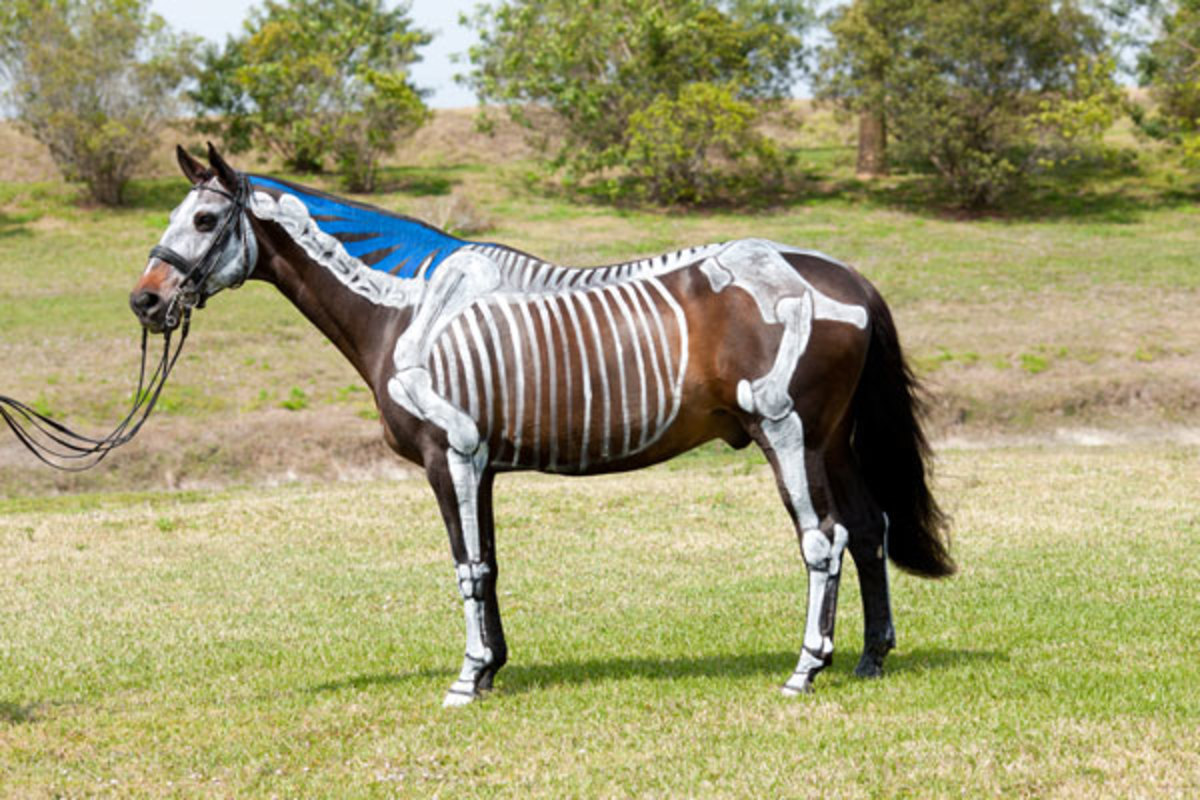
Our trainers help us ask for a movement correctly and help us to recognize when it feels right. But sometimes you might feel there is something missing in your understanding. It’s a feeling that you don’t quite understand what the horse is doing underneath you. It all happens or doesn’t happen so fast, and our perceptions of the horse can be confused by our own imbalances.
In the journey toward a better partnership, the more we as riders understand how the horse uses his body and what effect the work we are asking of him has on his body, the better we will be in sync with our mounts.
In an effort to provide insight into the dressage horse’s body, this article borrows material on several movements (extended trot, trot half pass, passage and piaffe) from a new DVD set, “Dressage Movements Revealed.”
The first DVD of this two-DVD set investigates how the dressage horse executes the upper-level movements by providing slow motion footage of a Grand Prix horse, Bacchus Delight, ridden by internationally recognized dressage trainer Betsy Steiner. Bacchus performs with the skeleton and the muscles painted on by equine anatomy artist Susan Harris.
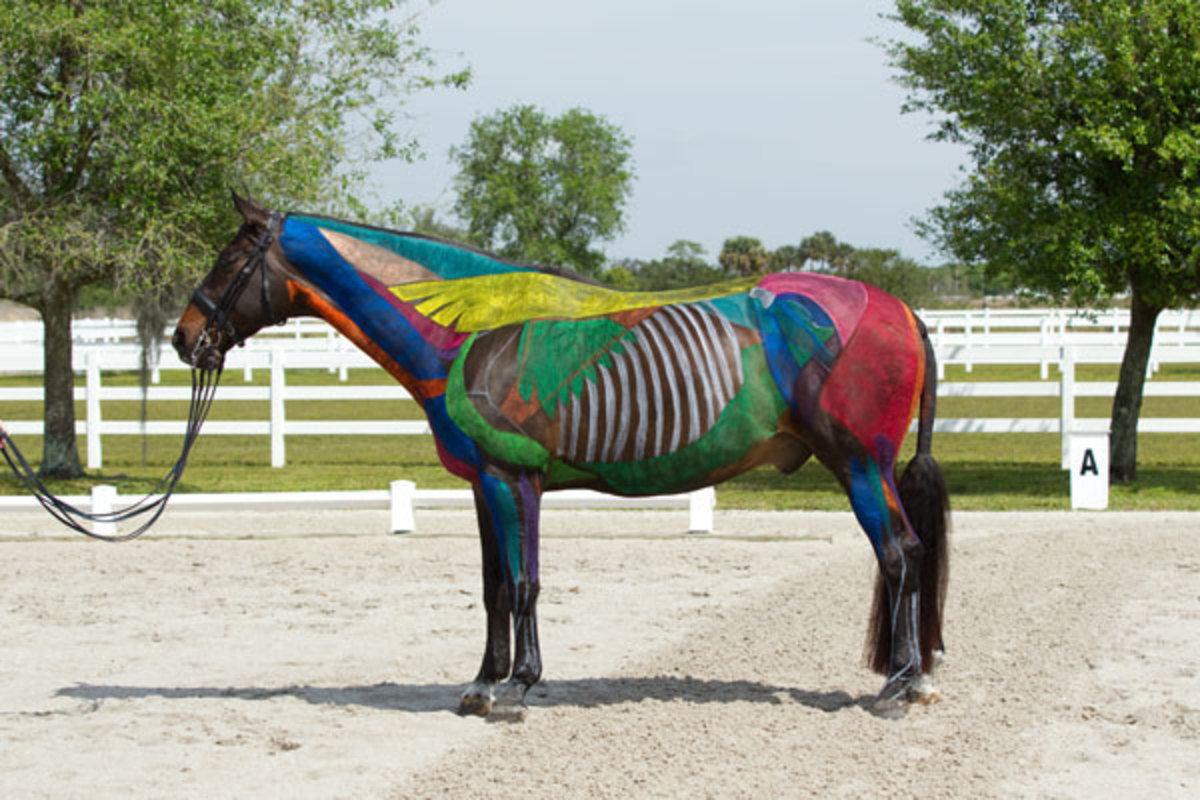
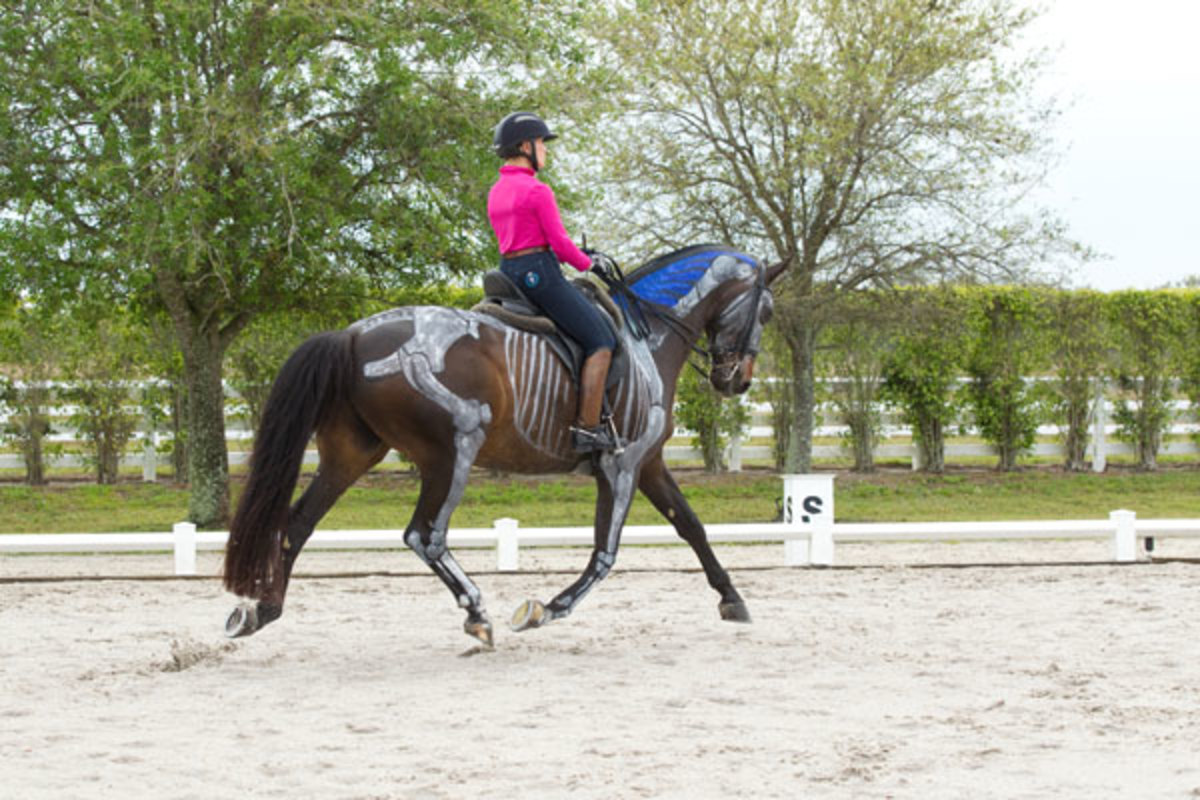
During the slow motion footage, Jim Masterson and Coralie Hughes, of the Masterson Method® for Integrated Equine Performance Bodywork®, and Steiner provide commentary from multiple perspectives on what is going on with the dressage horse during each of the movements.
The second DVD in the set captures Masterson demonstrating bodywork techniques that are easy to learn and perform on a dressage horse. The techniques he explains are designed to release tension and restore range of motion in the key junctions of the horse in a manner uniquely suited to dressage movement.
This article will provide you with a basic understanding of the equine anatomy to help you better understand how the horse uses his body. Thanks to the artistic work of Harris and Steiner’s demonstration exercises, we are able to explain how to apply a biomechanical understanding to each movement so you can become a more knowledgeable dressage rider.
HALF PASS: “This photo illustrates how the half pass is a lateral movement that calls for forward and sideways movement on a diagonal line with an even bend through his body,” says Coralie Hughes. “In general, bend is produced in part by the comparatively greater contraction of the inside long back muscle and the major abdominal muscles of the same side and the comparatively greater relaxation of the outer long back muscle and abdominal muscles.”
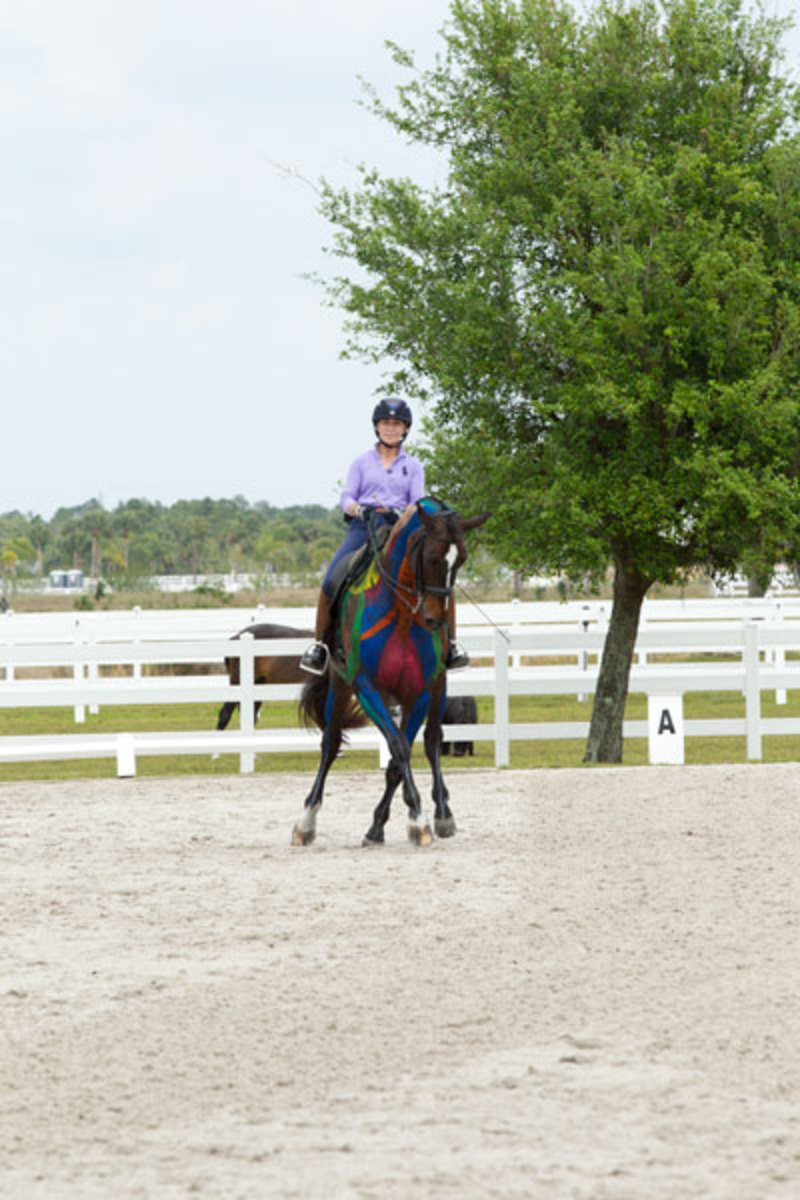
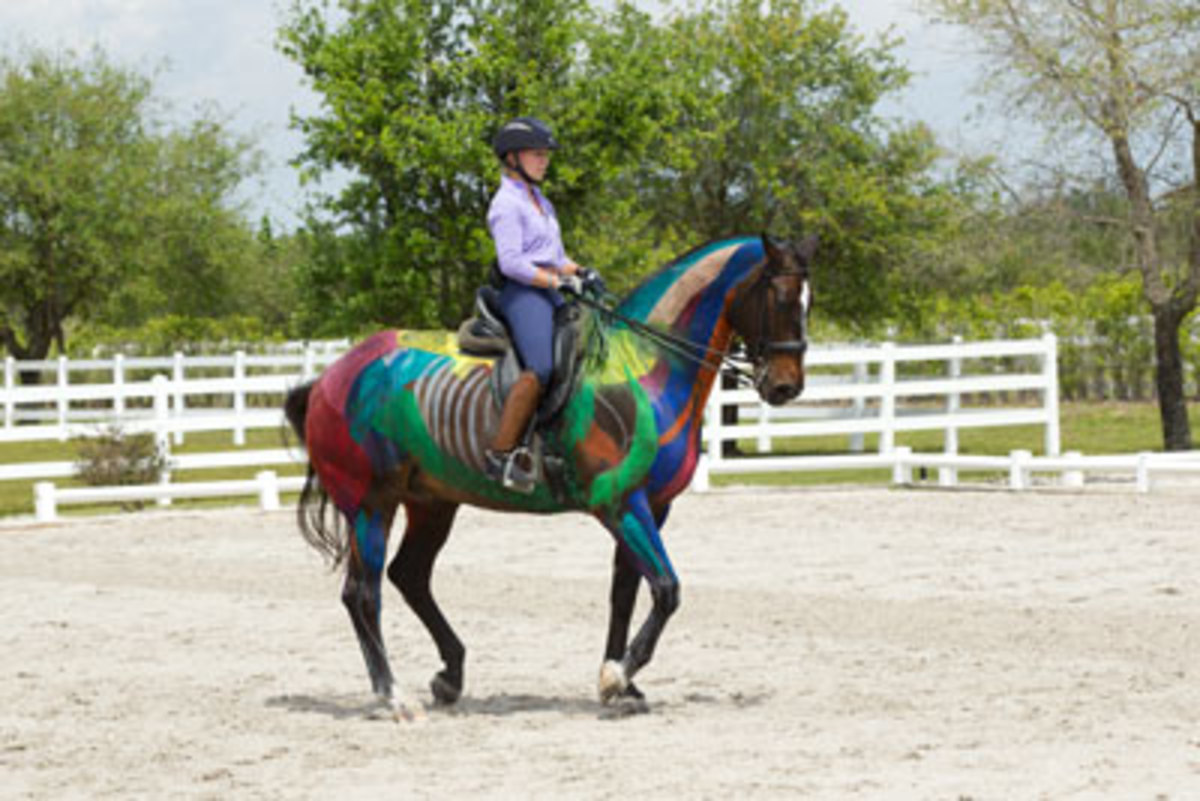
PIAFFE: “As we start into the piaffe, we want to really keep a nice balance throughout the horse’s entire body so that he can maintain his strides,” says Steiner. “You can see how each hind leg really has to come under. He really engages, lowers his haunches and lifts through his front.”
Basic Anatomy Simplified
The thought of equine anatomy can be intimidating, but it needn’t be so. For riders of any discipline, there are some concepts of the horse’s skeleton and musculature that are really important to understand, and it doesn’t require memorizing a lot of Latin names. In fact, it is pretty straightforward.
There are four main areas of the body that are important in dressage: the poll/atlas junction, the neck/shoulder/withers region, the sacro-lumbar/sacroiliac junction of the hindquarters and, especially for dressage horses, the back. There is also everything else in between. But here we will focus on these key areas that, if kept loose and supple, will go a long way toward keeping the horse’s entire body functioning in harmony and balance.
Let’s start by taking a look at your horse’s skeleton:
Poll/Atlas Junction:Starting at the head, we have the poll, where the horse’s head attaches to the first cervical vertebra—the C1 or atlas. Maintaining flexibility in the poll is key to maintaining suppleness in the entire horse. Here, the central nervous system passes from the horse’s brain to his entire body. Any tension here creates tension and restriction in the rest of the body. Conversely, tension that accumulates elsewhere in the body affects the poll. There is also a neurological connection between the atlas and the hind end and the sacrum.
Neck/Shoulder/Withers Junction: The horse’s neck is composed of seven cervical vertebrae. The first, C1, is attached to the head. Note that the cervical vertebrae run low in the neck and not along the topline as many believe. The lower end of the cervical spine attaches to the body at the first thoracic vertebra, at what we call the C7/T1 junction.
On either side of this junction, the horse’s forelimbs attach to the body via the shoulder blades (scapulae). Although the front leg attaches to a scapula at a shoulder joint, the scapula itself is not attached to the trunk by a joint, but with muscle and cartilage only. That means the entire foreleg is essentially attached to the body through muscle and connective tissue. This is an important junction as it is involved in forward and lateral movement of the forelegs, bend in the neck, suspension and the ability of the horse to lift his withers.
There is also a direct connection between this junction and the pelvis through the longissimus dorsi (long backmuscle), which attaches at one end to the vertebrae of the lower neck and at the other to the pelvis. This connection is regularly demonstrated during bodywork when the hind end relaxes following the use of techniques used to release tension at the shoulder.
Tension that accumulates in these muscles from work, repetitive movement, concussion and sore feet and legs will affect the freedom and range of motion of the front legs.
There are 18 thoracic vertebrae with ribs attached that form the trunk of the horse. As you can see from the photo above, the withers are actually long spinous processes that project up between the scapulae from the fourth through the eighth thoracic vertebrae (T4 through T8). They can be as long as 10 inches.
The blue structure painted on Bacchus in the photo above is the nuchal ligament. It runs from the sacrum, along the back, and hooks into the lower cervical spine and onto the poll.
The Horse’s Back:The area of the back where the rider sits is the thoracic spine that follows behind the withers. After the last thoracic vertebra and rib (T18), the lumbar spine begins. There are six lumbar vertebrae.
The thoracic part of the back provides support for the rider, but has limited mobility in the horse. It’s important to maintain the mobility that does exist in the back to enable longitudinal and lateral flexion.
The lumbar spine has nothing under it, and it looks vulnerable. It is a key area of the horse’s skeleton as the tremendous propulsive forces of the hindquarters are transmitted forward through the lumbar. Although there are no ribs attached to the lumbar vertebrae, there are wide lateral processes, or wings, that come off the six lumbar vertebrae. A saddle sitting too far back and hitting the lumbar vertebrae can cause pain due to the pressure on these lateral processes.
The junction of the last thoracic and first lumbar vertebrae (T18–L1) is an important transition point. Any imbalance behind due to soreness in the hocks, unilateral muscle tension or natural imbalance in the horse will create muscles spasms here.
In fact, the entire back can be thought of as not only support for the rider, but also a channel of power, connection and communication through the horse. If the back isn’t supple and functioning normally, then the entire body loses fluidity, balance and harmony.
Sacro-lumbar Junction and Sacroiliac Joint:The last lumbar vertebra attaches to the sacrum and hindquarters at a very important junction called the sacro-lumbar junction. The sacroiliac joint is the junction between the sacrum and the pelvis.
The sacro-lumbar junction can be imagined as a huge hinge joint that flexes forward and under, and extends out and behind, enabling the jumper to jump, the horse to gallop and the dressage horse to piaffe. Without freedom in this critical junction, the tipping of the pelvis in collection would not be possible.
The sacroiliac joint is the junction between the sacrum and the pelvis, and can be imagined as the main point through which the power generated by the hind limbs transfers into the body. This is not a bone joint but rather a large junction connected with large ligaments and large muscles.
Although this large junction can be injured through accidents such as slipping or falling, more often it is cumulative stress through overwork or imbalanced conditioning that creates problems here.
The hip joint is a ball-and-socket joint akin to the human shoulder and it attaches the hind leg to the pelvis. One of the largest driving muscles, the middle gluteal muscle, attaches to the femur at the hip joint. Overwork of the gluteal muscles can create restriction in the hip joints. Restriction in the rotational reach of the hip joint dramatically affects the dressage horse’s ability to correctly perform.

Muscle Movement and Joints: Muscles produce movement by flexing and straightening a joint between two bones or parts of the skeleton (for example, the hock, between the tibia and the cannon bone). They work in pairs, so that as the horse fires one muscle to contract a joint, the other muscle in the pair must fully relax for the joint to move.
For the joint to truly extend, the muscles work in reverse. The muscle that had to relax for flexing the joint must now contract to extend or fully open the joint and the other muscle must now fully relax. Muscles can’t push, they can only “pull” (contract) or “not pull” (relax).
Simplistically, muscles in front of the limb pull it forward and the muscles behind the limb pull it back. Muscles between the two forelimbs (pectorals) and two hind limbs (groin muscles) are involved in lateral movement. After the leg is swung forward or to the side, the foot becomes planted on the ground. As the leg appears to be drawn back to the body, muscular contraction is actually pulling the whole body over the leg, a big task.
Muscles, Tendons and Ligaments:Muscles and connective tissue such as tendons and ligaments comprise 60 percent of the horse’s body weight. You are probably familiar with what muscles are, but what’s the difference between tendons and ligaments? Tendons are harder tissue on the end of the muscle that attach the muscle to the bone. Ligaments are even harder tissue that connects bones to bones. These are what support the joints and keep them together.
Muscle Groups and Chains: The muscles not only work in pairs or groups around a joint, they also work in chains that combine to form a circle of muscles. This is an important concept to understand for riding because tightness in one part of the chain can have far-reaching effects farther down the chain.
Keeping it simple, there are two primary chains: the dorsal chain, which goes over the back along the whole top-line of the horse, and the ventral chain, which makes up the bottom line of the horse. The two chains work together to create a circle of muscles that facilitates precise control and the continuous, flowing movement of the horse.
Without strength and suppleness in both the topline and bottom-line muscles, the abdominals could not lift the back to carry the rider and there could be no collection. The muscle chains must be in balance for a horse to perform with energy and suppleness.
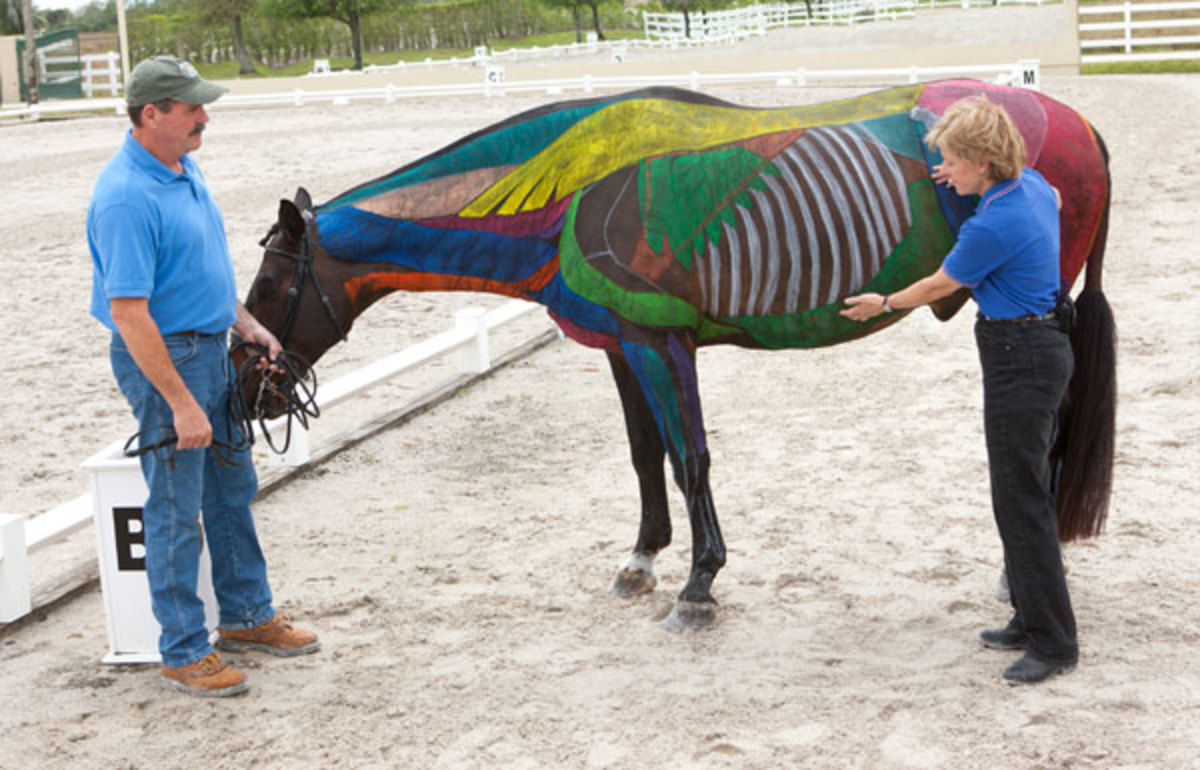
Muscles and Conditioning
Over time, with repetitive motion from any type of work, a muscle’s ability to fully relax can become compromised. If a muscle continues to go through a repetitive cycle of contracting and releasing, eventually it can become tighter and tighter, and the range of motion of the joint will become more and more restricted.
The freedom of movement necessary for big gaits requires that the muscles be able to work in a healthy manner, fully able to contract and fully relax to properly flex and extend the joints.
In addition, if one muscle or even one area of the horse is overworked, becomes tight and loses its ability to work in a healthy manner, then another muscle or part of the body has to work harder to make up the difference. This is why measured, progressive conditioning as outlined in the Training Scale is very important to keep in mind.
It’s helpful to know that even though a horse is willing or able to perform a certain movement, tightness and restriction could be having a hidden or long-term negative effect on his skeleton and muscles.
One more thing to keep in mind as we look at dressage movements in the horse is the natural predominance in horses of one side over the other. People often notice that a horse will often bend better on one side than the other or pick up a canter lead more easily in one direction than the other. Horses are similar to right-handed and left-handed humans in this respect.
The conditioning and suppling qualities inherent in dressage can develop a more even, well-balanced horse. However, repetitive work without proper suppling can create imbalances in tension described in the previous paragraph or embed this natural crookedness even further.
We hope that this discussion gives you a sense of how the horse’s body works and the role interconnection plays in his movement.
All of the parts must work together in balance and harmony to create that magical movement we strive for in dressage. If one area of the horse is working harder to compensate for an imbalance or tightness in another area, then the stress on that overworked area will take its toll. We must remember that strength, suppleness and balance are interwoven through all layers of dressage work to produce the pinnacle of collection and throughness.
Coralie Hughesis a Masterson Method® advanced course instructor and certified practitioner, as well as a USDF bronze medalist and “L” Education Program graduate with distinction. She works out of her farm in Coatesville, Indiana.
Betsy Steinerhas successfully trained many horses to Grand Prix. She has competed internationally and achieved Grand Prix wins at prestigious shows in the U.S. She is a USDF bronze, silver and gold medalist and sought-after clinician and panelist (steinerdressage.com).
Jim Masterson was the equine massage-bodywork therapist for the 2006, 2008, 2010 and 2012 USET Endurance Teams. He has worked on horses competing in the FEI World Cup, and Pan American and World Equestrian Games (mastersonmethod.com).
Dressage Movements Revealed was co-authored by Betsy Steiner, Jim Masterson and Coralie Hughes. To learn more, visit HorseBooksEtc.com.











